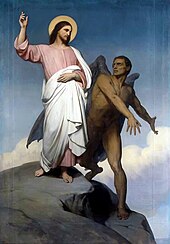Ary Scheffer
Politically, Scheffer had strong ties to King Louis Philippe I, having been employed as a teacher of the latter's children, which allowed him to live a life of luxury for many years until the French Revolution of 1848.
In 1811 he and his mother, who greatly influenced his career, moved to Paris, France, where he studied at the École des Beaux-Arts as a pupil of Pierre-Narcisse Guérin.
On 30 July, Scheffer and influential journalist Adolphe Thiers rode from Paris to Orléans to ask Louis Philippe I to lead the resistance, and a few days later he became "King of the French".
Scheffer and Hendrik were inundated with artistic commissions, and they taught numerous students in their workshop in Paris, so many that of the works produced during this period that bear his signature the number that he actually made himself cannot be verified.
The cruelty and hatred that the governmental faction exhibited and the misery of the lower classes so shocked him that he withdrew from politics and refused to make portraits of the family of Napoléon III, who reigned after the Uprising.
On 16 March 1850 he married Sophie Marin, the widow of General Baudrand, and on 6 November of that year he finally became a French citizen.
When Scheffer left Guérin's studio, Romanticism had come into vogue in France, with such painters as Xavier Sigalon, Eugène Delacroix and Théodore Géricault.
[8] His L'Enterrement du Jeune Pêcheur, illustrating a scene from Walter Scott's The Antiquary and taking inspiration from David Wilkie's Distraining for Rent, was exhibited at the Salon of 1824.
In the piece the entwined bodies of Francesca di Rimini and Paolo Malatesta swirl around in the never-ending tempest that is the second circle of Hell.
By the time of his death, his reputation was damaged and was further undermined by the sale of the Paturle Gallery, which contained many of his most celebrated achievements: though his paintings were praised for their charm and facility, they were condemned for poor use of color and vapid sentiment.
[12] At various times Maurice Sand, Scheffer, Charles Gounod, Hector Berlioz were in relationships with Pauline Viardot—in letters they claimed that they were in love with her.
[14] She was married to Louis Viardot at 18 years old, when her husband was a director of an Italian opera house in Paris and a friend of Scheffer.
[14][15] In 1850 Scheffer became a French citizen and married Sophie Marin, the widow of General Marie Étienne François Henri Baudrand.








